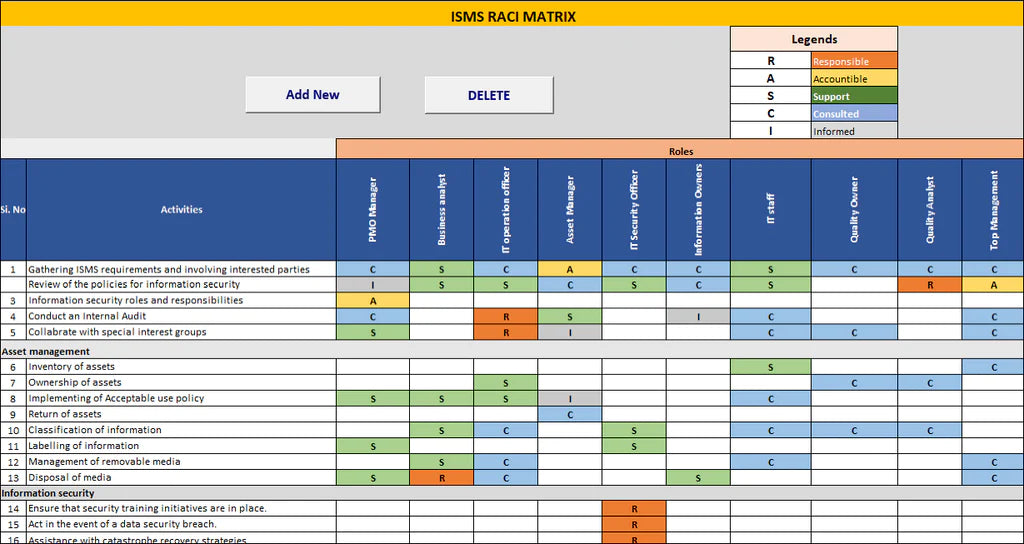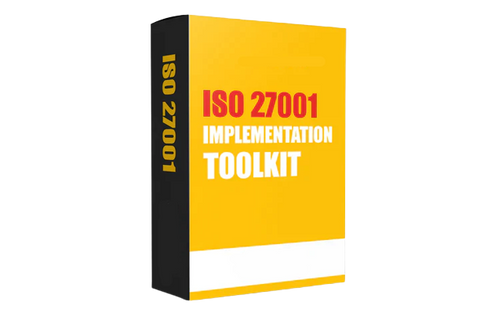ISO 27001:2022 ISMS RACI Matrix Template
The ISMS RACI Matrix serves as a valuable tool for ensuring the effectiveness of an organization's Information Security Management System (ISMS). It functions by delineating roles and responsibilities within the ISMS pinpointing any gaps in accountability. This matrix applies to organizations of all sizes but is particularly advantageous for larger, more complex ISMS implementations. Its primary purpose is proactively addressing issues and conflicts while establishing a shared understanding of expectations among all involved parties.

How Does the ISMS RACI Matrix Operate?
The ISMS RACI Matrix functions by charting the duties and obligations of individuals and groups involved in an organization's ISMS. It helps identify those accountable for specific tasks within the ISMS and uncovers any deficiencies in responsibility distribution. This matrix is structured into four distinct quadrants:
- Responsible: This designates the individual or group entrusted with the task's execution. They possess the authority to make decisions regarding the task and are answerable for its successful completion.
- Accountable: This identifies the individual or group responsible for the task, having the authority to delegate the task to others but not bearing direct responsibility for its ultimate success.
- Consulted: This specifies the individuals or groups seeking input about the task. They provide valuable insights and recommendations but lack decision-making authority.
- Informed: This pertains to individuals or groups informed about the task's progress and status. They are not directly involved in its execution but are updated on its developments.
Advantages of the RACI Matrix
- Improved Communication Efficiency: Using a RACI matrix facilitates efficient communication by engaging the right individuals at the appropriate moments, expediting and simplifying decision-making processes.
- Enhanced Delegation Accessibility: A designated project leader is a point of contact for guidance, queries, and feedback. The matrix ensures that task delegation is well-managed and all team members understand their roles and responsibilities.
- Enhanced Clarity of Expectations: With everyone involved in the project aware of who is responsible for completing each task, ambiguity is eliminated. This also assists key stakeholders in comprehending their specific responsibilities.
- Streamlined Stakeholder Input: By distinguishing between vital stakeholders who require active engagement for information and those who need to be kept informed, you can reduce feedback delays, ensuring that only the pertinent parties remain up-to-date. caution.
How to Construct a RACI Matrix
- Task Enumeration: Begin by cataloging all the tasks and deliverables essential for the successful completion of the project. These should be placed in the leftmost column of the chart. While the chart can encompass numerous activities, strive to maintain a balance, avoiding excessive granularity for readability.
- Conduct Meetings and Allocate RACI Codes: Effectively managing a business entails overseeing numerous facets. One strategy for aligning everyone with a common purpose is to hold regular stakeholder meetings. During these meetings, it is imperative to assign RACI codes to each team member. The assignment of these codes ensures that everyone comprehends their role in the meeting and the overarching objective.
- Share the Matrix: Your matrix should be openly discussed and disseminated to the team. To address potential conflicts or misunderstandings concerning roles and responsibilities, engage in dialogues about each individual's assigned duties and actively solicit input.
How to Implement the ISMS RACI Matrix in Your Business
- Define Organizational Roles and Responsibilities: Start by delineating the roles and responsibilities of every member within your organization. This can be achieved by creating comprehensive position descriptions for each role or utilizing an existing organizational chart. A clear understanding of each individual's role within the organization is essential.
- Task Assignment with Consideration: After clarifying the roles, you can assign tasks and activities to the appropriate individuals. It is imperative to consider the qualifications and expertise of team members when allocating tasks. For example, if you're implementing a new security system, it's wise to assign the responsibility of designing and implementing the system to someone with a background in information security. Similarly, for introducing a new training program, the task is responsible for developing and delivering the training to someone experienced in training development.
- Populate the ISMS RACI Matrix: The next step involves filling out the ISMS RACI Matrix, which consists of four quadrants: responsible, accountable, consulted, and informed. Each quadrant corresponds to a different individual within your organization.
- Responsible Quadrant: Typically occupied by the individual responsible for executing the task or activity. In most cases, this aligns with the person to whom the task has been assigned. However, there may be instances where multiple individuals jointly share responsibility for a single task or activity. In such cases, all involved individuals should be listed as "responsible."
- Accountable Quadrant: Usually held by the individual ultimately responsible for completing the task or activity. This role may be assumed by a project manager, department head, or even the CEO. There might be instances with multiple individuals in this quadrant.
- Consulted Quadrant: Generally occupied by individuals whose input should be sought before the task or activity commences. These individuals typically possess expertise or knowledge that can benefit the person executing the task. However, it's important to note that consultation is not mandatory, and these individuals may choose not to participate.
- Informed Quadrant: Typically filled with individuals who need to stay informed about the progress of the task or activity. While not directly involved in the task's execution, they must be kept apprised of its developments.
Conclusion
ISMS RACI Matrix Template proves to be an invaluable asset in the successful implementation and management of an Information Security Management System (ISMS). This template streamlines roles and responsibilities by clearly defining who is Responsible, Accountable, Consulted, and Informed in various ISMS processes.
By utilizing this matrix, organizations can enhance communication, streamline decision-making, and ensure accountability across the ISMS framework. It serves as a practical tool in achieving and maintaining ISO 27001:2022 certification, reinforcing a structured approach to information security governance and fostering a culture of continuous improvement within the organization.



